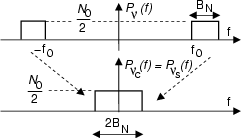In questo caso, per ottenere una
![]() x =
x = ![]()
![]() M
uguale al caso BLD-PS, le componenti
xc
M
uguale al caso BLD-PS, le componenti
xc![]() t
t![]() ed
xs
ed
xs![]() t
t![]() devono essere poste pari a
devono essere poste pari a
![]() m
m![]() t
t![]() e
e
![]()
![]()
![]() t
t![]() , rispettivamente (vedi § 9.4.1).
, rispettivamente (vedi § 9.4.1).

Dunque, si ottengono prestazioni identiche a quelle BLD. Si noti che
il risultato Ŕ valido solo se
![]()
![]() t
t![]() Ŕ effettivamente limitato
alla sola banda BRF. Se infatti si fosse adottato un filtro con banda
pi˙ larga, come ad esempio un
HR
Ŕ effettivamente limitato
alla sola banda BRF. Se infatti si fosse adottato un filtro con banda
pi˙ larga, come ad esempio un
HR![]() f
f![]() con BN = 2W,
si sarebbe ottenuto
con BN = 2W,
si sarebbe ottenuto
![]()
![]()
![]() f
f![]() = N0, ed
SNR risulterebbe dimezzato.
= N0, ed
SNR risulterebbe dimezzato.